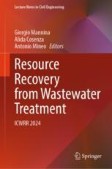Search
Search Results
-
Dye Removal Characteristics of Magnetic Biochar Derived from Sewage Sludge: Isotherm, Thermodynamics, Kinetics, and Mechanism
The efficient and relatively simple modification of various biochars to facilitate their environmental applications and enhance the...

-
Biochar as a highly efficient adsorption carrier for sewage sludge-derived nutrients and biostimulants: component fixation and mechanism
Production of liquid fertilizers containing nitrogenous nutrients and biostimulants from sewage sludge (SS-NB) has been attracting increasing...

-
Sewage Sludge: Is It a Sustainable Fertilizer or a Source of Contaminants?
Sewage sludge is the leftover from municipal and industrial wastewater treatment plants which contains both essential nutrients and contaminants such...
-
Cadmium and lead removal by Mg/Fe bimetallic oxide-loaded sludge-derived biochar: batch adsorption, kinetics, and mechanism
Biochar is a valuable adsorbent for the removal of heavy metals from water, and it is important to explore ways to increase its heavy metal...

-
Systematic physicochemical characterization, carbon balance and cost of production analyses of activated carbons derived from (Co)-HTC of coal discards and sewage sludge for hydrogen storage applications
Hydrothermal carbonization (HTC) technologies for producing value-added carbonaceous material (hydrochar) from coal waste and sewage sludge (SS)...

-
Adsorptive Removal of Heavy Metals from Wastewater Using Low-Cost Adsorbents Derived from Agro-based Materials
Recently, anthropogenic activities have evolved into sources of pollution, particularly when it comes to the discharge of harmful heavy metals into...
-
Preparation of Sewage Sludge as Substrate for Biochar Production
Sludge is the solid byproduct resulting from sewage treatment, excluding screened materials and sand. Effective management of sludge is crucial to...
-
A Review on Sewage Sludge Valorization via Hydrothermal Carbonization and Applications for Circular Economy
In pursuit of establishing a circular economy, a waste-to-energy approach is gaining increasing attention. Valorization of sewage sludge constitutes...

-
Advanced adsorbents for ibuprofen removal from aquatic environments: a review
The presence of pharmaceuticals in ecosystems is a major health issue, calling for advanced methods to clean wastewater before effluents reach...

-
Advances in Modified Wood-Based Adsorbents for Contaminant Removal: Valorization Methods, Modification Mechanisms, and Environmental Applications
Purpose of ReviewWood-based adsorbents are increasingly used for environmental applications. They demonstrate considerable advantages, including...

-
NaHCO3 activated sludge-derived biochar by KMnO4 modification for Cd(II) removal from aqueous solutions
The surface flat pristine biochar provides limited adsorption sites for Cd(II) adsorption. To address this issue, a novel sludge-derived biochar...

-
A Comprehensive Review on Green and Eco-Friendly Nano-Adsorbents for the Removal of Heavy Metal Ions: Synthesis, Adsorption Mechanisms, and Applications
Purpose of ReviewEnvironmental pollution stemming from industrial, agricultural, and domestic activities is constantly increasing. The removal of...

-
An Update on Agricultural Wastes Used as Natural Adsorbents or Coagulants in Single or Combined Systems for the Removal of Dyes from Wastewater
Over a billion people in develo** countries do not have access to clean water. Industries such as textiles, tanneries, and plastics release...

-
Effective removal of heavy metal: mercury concentration using natural adsorbents
Industrial effluent is not always safe to the environment because of the presence of huge amounts of substantial heavy metals like arsenic, cadmium,...

-
Bimetallic adsorbents for wastewater treatment: a review
The rising pollution of water resources is threatening the health of humans and ecosystems, calling for advanced methods to clean polluted waters....

-
Removal of Ammonia Nitrogen from Aqueous Media with Low-cost Adsorbents: a Review
Ammonia nitrogen pollutant in aqueous media is difficult to treat, which leads to a deterioration of pristine water ecosystems because of...

-
New porous amine-functionalized biochar-based desiccated coconut waste as efficient CO2 adsorbents
Climate change caused by the greenhouse gases CO 2 remains a topic of global concern. To mitigate the excessive levels of anthrophonic CO 2 in the...

-
Studies on ultrafast and remarkable removal of phosphate from sewage water by metal-organic frameworks
In the proposed research, a lanthanum-doped metal-organic framework (La-ATP) has been synthesised to remove phosphate from contaminated aqueous...

-
Recent Trend and Evaluation of Bio-assisted Adsorbents for the Removal of Emerging Pollutants and Its Adsorption Mechanisms
Emerging pollutants (EPs) are a group of toxins with low concentrations but substantial toxicity. In recent years, the environment has gained a lot...

-
Impact of metal polluted sewage water on soil nematode assemblages in agricultural settings of Aligarh, India
Sewage water in agriculture threatens human health and soil ecosystems through metal pollution.
Nematodes show promise as bioindicators of soil health...

